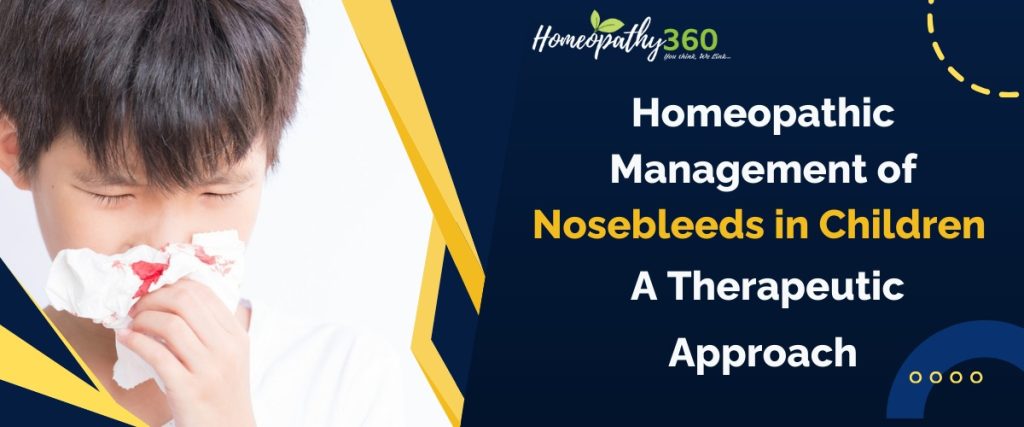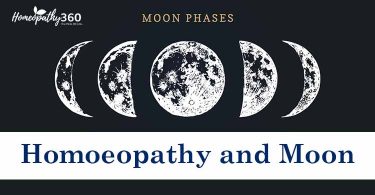
Abstract – Nosebleeds, medically termed epistaxis, result from bleeding in the nasal mucous membranes due to broken blood vessels. In children, most occur in the anterior part of the nose, near the nostrils, where tiny, fragile blood vessels are easily damaged. These are usually minor. Posterior nosebleeds, which are closer to the throat, are rare in children but can lead to significant blood loss. Currently, various therapeutic options and guidelines have been developed to manage recurrent and persistent epistaxis effectively. Advances in treatment strategies and clinical interventions have contributed to improving its management. This article reviews the available literature on epistaxis, focusing on treatment protocols and therapeutic approaches. It also addresses the condition’s pathophysiology, causes, and initial clinical assessment, along with an exploration of the homeopathic perspective. [1]
Keywords: Epistaxis, homoeopathic management, Nasal packing, treatment protocols Genetic Haemorrhage, Nosebleed.
Introduction – Epistaxis has been recognized since ancient times, with early treatments documented in the Edwin Smith Papyrus and methods by Hippocrates, including nasal packing and pressure application. In the 19th century, modern understanding evolved with the identification of Kiesselbach’s plexus as a key bleeding site. Surgical advancements like carotid and maxillary artery ligations followed. [2]
Epistaxis is a common ENT issue, accounting for a significant number of emergency referrals. Approximately 60% of people experience nosebleeds during their lifetime. It exhibits two age-related peaks: children under 10 and adults over 60. Causes include primary (idiopathic) in 70–80% of cases and secondary, related to systemic diseases or anticoagulant use. Venous bleeding is frequent in young children (ages 3–5) with short episodes, while arterial bleeding occurs in older individuals with prolonged bleeding. Most cases (98%) originate from Little’s area on the nasal septum.[3]
Most Common Causes Of Epistaxis –
Here is a summarized and reorganized table of the content provided, common cause of epistaxis.[4]
| Category | Subcategory | Examples/Details |
|---|---|---|
| Local | Acquired | Infective: Viral, bacterial, fungal infections; chronic conditions like tuberculosis. |
| Inflammatory | Rhinosinusitis (allergic/vasomotor), nasal polyposis (e.g., cystic fibrosis, allergies). | |
| Trauma | Digital trauma (nose-picking), foreign body/rhinolith, surgery (e.g., carotid aneurysm). | |
| Idiopathic | Mild recurrent nosebleeds (e.g., from Little’s area, middle meatus, Woodruff’s plexus). | |
| Neoplastic | Benign: Hemangioma; Malignant: Lymphoma. | |
| Drug-induced | Rhinitis medicamentosa (e.g., topical decongestants/cocaine), inhalants, tobacco. | |
| Environmental | High altitude, rapid temperature changes, dry conditions. | |
| General | Bleeding disorders | Coagulopathies: Inherited (hemophilia A/B, factor IX deficiency); acquired (e.g., liver disease). |
| Platelet disorders: Thrombocytopenia (congenital, acquired: marrow failure, drugs); dysfunction (e.g., von Willebrand’s). | ||
| Blood vessel disorders: Congenital (telangiectasia); acquired (e.g., vitamin C deficiency). | ||
| Hyperfibrinolysis: Congenital (alpha-2 antiplasmin deficiency). | ||
| Drugs | Aspirin, anticoagulants, chloramphenicol, methotrexate, dipyridamole. | |
| Neoplasms | Similar to “Local” section. | |
| Idiopathic | Includes inflammatory conditions like Wegener’s granulomatosis. | |
| Others | HIV-related bleeding. |
There are two important areas in the nose that play a role in Epistaxis:
• Kiesselbach’s plexus, also referred to as Little’s area, is located on the anterior nasal septum and consists of an anastomosis of several blood vessels. It is a common site for anterior nosebleeds due to its rich vascular supply. illustrated in Fig.1.
illustrated in Fig.1.
Fig.1
• Woodruff’s plexus is situated over the posterior middle turbinate and is formed by a network of vessels. This area is often the source of posterior nosebleeds, which tend to be less common but more severe. illustrated in Fig.2.
Fig.2
AETIOLOGY OF EPISTAXIS – Most childhood nosebleeds (approximately 90%) occur in Little’s area, a vascular region in the anterior nasal septum. These are commonly idiopathic or result from trauma, such as nose-picking or forceful blowing. Contributing factors may include allergic rhinitis, upper respiratory infections, or nasal foreign bodies causing local inflammation or infection. Posterior epistaxis in children is rare and often linked to underlying conditions like bleeding disorders, inflammation, or neoplasms. Persistent or recurrent bleeding warrants further evaluation to rule out systemic causes or serious conditions. [5]
Here’s the content arranged in a table format:
| Category | Details |
|---|---|
| Anterior Epistaxis | Originates from Little’s area in 90% of cases in children. Often idiopathic or trauma-induced. |
| Causes include nose-picking, forceful blowing, sneezing, and increased pressure on nasal vessels. | |
| Associated with conditions like allergic rhinitis, viral/bacterial upper respiratory infections, and trauma/sepsis due to foreign bodies. | |
| Posterior Epistaxis | Rare in children, usually linked to bleeding disorders, inflammatory conditions, or neoplasms. |
| Persistent/Recurrent Epistaxis | May indicate systemic causes such as coagulopathies or neoplastic conditions, requiring further investigation. |
Homoeopathic Approach and Management- A detailed history and comprehensive systemic examination are crucial to identify any underlying systemic diseases or bleeding disorders, such as petechiae, purpura, ecchymosis, or hepatosplenomegaly, which may require further investigation. Blood dyscrasias account for up to one-third of habitual epistaxis cases in children, with family history and prolonged partial thromboplastin time (PPT) serving as key predictive indicators. Severe cases requiring resuscitation are rare but indicate complex conditions. For anterior nosebleeds, applying pressure by pinching the nostrils in an upright position typically controls venous bleeding.
Homoeopathic remedies act beautifully in both acute as well as chronic nose bleeding as these medicines have a marked action on blood vessels of the nose.
Homoeopathic Medicines for Epistaxis are:-
- Phosphorus: Bright red bleeding, even from minor triggers. Suitable for sensitive, cheerful children with thirst for cold drinks. Worse in the evening; better in cool air. Bleeding from gums or other sites.[7]
- Pulsatilla: Nosebleeds in warm environments or following emotional stress, often with a congested nose. Worse in warm rooms; better in fresh, open air. Mild, emotional, and clingy.[8]
- Arnica Montana: Nosebleeds caused by trauma, with dark, clotted blood. Worse from physical touch or movement. Bruised sensation throughout the body.[9]
- Ferrum phosphonium: Bright red bleeding in the early stages of inflammation, especially in pale, anemic children. Worse at night; better with cold applications.[10]
- Hamamelis virginica: Dark, persistent bleeding with venous congestion. Worse with motion; better with cold compresses.[11]
- Calcarea phosphoricaum: Recurrent nosebleeds in children with weak constitutions or delayed milestones. Worse in cold and damp weather. Poor nutritional absorption and general weakness.[12]
- Ammonium Carb: – Ammonium carb is suited to stout women who are tired and weary and who are disposed to use a smelling-bottle. Epistaxis in patients coming on from activities like washing face and after eating. Nasal discharges are bloody Ozaena with bloody mucous from the nose. Children with a sudden stoppage of breathing from the nose with snuffles.[13]
- Ambrosia
- Ambrosia is indicated in bleeding from the nose due to cold, rhinitis, and whooping cough. Watery coryza with sneezing also gives a stuffed up feeling in the head and nose. Ambrosia is indicated in cases of bronchitis with a nose bleed. According to William Boericke 10 drops in water during and after the attack of epistaxis.[14]
- Melilotus
- Epistaxis with bright red blood and this relieves sick headache in Melilotus. Congestion and haemorrhages seem to be a special manifestation of this drug. Hard clinkers in the nose. Nose stopped up, dry must breathe through the mouth. [15]
- Bryonia
- Bryonia is indicated in epistaxis when there is vicarious menstruation. When there is frequent bleeding from the nose when menses should appear. Epistaxis in the morning which relieves the headache. Epistaxis with swelling of the tip of the nose feels as if it would ulcerate when touched. Epistaxis is worse by slightest motion and relieved by rest. The patient is very thirsty with dryness of mouth and throat. [15]
Supportive Management
In addition to homeopathic remedies, lifestyle measures can play a vital role in managing and preventing nosebleeds. [16,17]
- Humidify the environment: To combat dryness and prevent mucosal cracking.
- Encourage hydration: Ensuring adequate fluid intake keeps the mucosa healthy.
- Nutritional supplements: Include foods rich in Vitamin C and iron to strengthen blood vessels.
- Prevent nasal trauma: Educate children on avoiding nose-picking or rough handling of the nose.
REFERENCES:
- https://www.hopkinsmedicine.org/health/conditions-and-diseases/nosebleeds#:~:text=What%20is%20a%20nosebleed%20in,nose%20close%20to%20the%20nostrils.
- https://www.reliasmedia.com/articles/122580-management-of-epistaxis-in-the-emergency-department
- Padgham N. Epistaxis: anatomical and clinical correlates. The Journal of laryngology and otology 1990;104 (4):308-11
- Clinical Practice Guidelines for Epistaxis by the American Academy of Pediatrics:
https://publications.aap.org/pediatrics/article/145/4/e20200283/36965/Clinical-Practice-Guideline-Nosebleed-Epistaxis - https://journals.sagepub.com/ Otolaryngology-Head and Neck Surgery Resources.
- JACQUES VILJOEN MB ChB, MMed ORL Private ENT Surgeon Linmed Hospital Benoni and Brooklyn Surgical Centre and Montana Hospital Pretoria Dr Jacques Viljoen is an ear, nose and throat surgeon in private practice at the Linmed Hospital, Benoni and Montana Hospital and the Brooklyn Surgical Centre in Pretoria. He takes a keen interest in rhinology,especially aesthetic nose surgery and the management of rhino-sinal condition, as well as microscopic ear.
- Pocket Manual of Homoeopathic Materia Medica &Repertory(2nd edition).
- Comparative Materia Medica by F. A. Farrington(reprint edition 2003)
- (Reference: Boericke W., Pocket Manual of Homeopathic Materia Medica, 1927)
- (Reference: Clarke J.H., A Dictionary of Practical Materia Medica, 1900)
- (Reference: Kent J.T., Lectures on Homeopathic Materia Medica, 1905)
- (Reference: Boericke W., Pocket Manual of Homeopathic Materia Medica, 1927)
- (Reference: Clarke J.H., A Dictionary of Practical Materia Medica, 1900)
- (Reference: Allen T.F., Handbook of Materia Medica and Therapeutics, 1874)
- http://homeoint.org/books/allkeyn/index.htm.
- “Clinical Practice Guideline: Nosebleed (Epistaxis).” American Academy of Pediatrics.
- ENT textbooks and peer-reviewed journals such as Otolaryngology–Head and Neck Surgery.
ABOUT AUTHOURS:
Dr. Dharmendra dixii
MD Scholar,
Department of Paediatrics,
Government Homoeopathic Medical College and Hospital,
AYUSH Campus, MACT Hills, Bhopal, Madhya Pradesh, India
Dr. Ajay Singh Parihar
Professor and H.O.D,
Department of Paediatrics,
Government Homoeopathic Medical College and Hospital,
AYUSH Campus, MACT Hills, Bhopal, Madhya Pradesh, India





